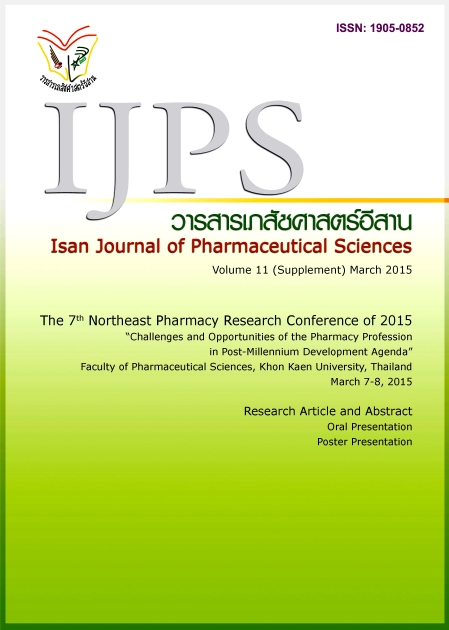Study of primary chemical compositions, nutritional values, and antibacterial properties of Ma-now-mai-roo-hoo (Carissa carandas L.)
Main Article Content
Abstract
Introduction: Ma-now-mai-roo-hoo (Carissa carandas L.) is a common plant in Apocynaceae family, which is normally used in the Indian medicinal System, particularly, Ayurveda. This study aimed to investigate the primary chemical compositions, nutritional values, and antibacterial activities of 2 phases of unripe and ripe Ma-now-mai-roo-hoo namely (1) Pulp + peel of unripe: PP(W/R), (2) Seed coat + seed of unripe: PS(W/R), (3) Pulp + peel of ripe: PP(Dm) and (4) Seed coat + seed of ripe: PS(Dm). Materials and Method: Nutritional values of Ma-now-mai-roo-hoo were studied by Proximate analysis. The chemical compositions of methanolic extraction of the fruit were determined using Thin Layer Chromatography (TLC). In the study, Staphylococcus aureus (S. aureus) and Escherichia coli (E. coli) were used as model bacteria in the antibacterial experiment. Results: It was found that all extract contained of phenolic, flavonoids, tannin, coumarins, anthraquinones, terpenes and steroids. PP(Dm) exhibited the highest nutritional values indicated by total energy obtained from fat (12.30 ± 0.29%), protein (13.84 ± 0.37%) and carbohydrates (51.14 ± 0.78%) compared to other parts. Furthermore, PP(Dm) and PP(W/R) methanolic extractions had antibacterial effect both bactericidal and bacteriostatic properties, whereas those of PS(W/R) and PS(Dm) had less effects. Conclusion: The unripe and ripe fruits of Ma-now-mai-roo-hoo showed a potential capacity as additional nutrition source and being able to develop for alternative products.
Article Details
In the case that some parts are used by others The author must Confirm that obtaining permission to use some of the original authors. And must attach evidence That the permission has been included
References
(AOAC) AoOAC. Official Methods of Analysis of AOAC International. USA: Maryland; 2000.
Agarwal, T., Singh, R., Shukla, A. D., & Waris, I. In vitro study of antibacterial activity of Carissa carandas leaf extracts. Asian Journal of Plant Science and Research,2012; 2(1), 36-40.
Itankar, P. R., Lokhande, S. J., Verma, P. R., Arora, S. K., Sahu, R. A., & Patil, A. T. Antidiabetic potential of unripe Carissa carandas Linn. fruit extract. Journal Ethnopharmacology,2011; 135(2), 430-433.
Kubola, J., Siriamornpun, S., & Meeso, N. Phytochemicals, vitamin C and sugar content of Thai wild fruits. Food Chemistry. 2011; 126(3), 972-981.
Maheshwari R, Sharma A, Verma D. Phyto-therapeutic Significance of Karaunda. Bulletin of Environment Pharmacology and Life Sciences. 2 01 2; 1(12), 6-34.
Mishra CcK, Shrivastava B, Sasmal D. Pharmacognostical standardization and phytochemical identification of fruit and root of Carissa carandas Linn. International Journal of Pharmacy and Pharmaceutical Sciences. 2013; 5(3), 347-350.
Noppamas Soonthornchareonnon. Phytochemistry. Faculty of Pharmacy, Mahidol University. Thailand: Bangkok; 2004.
Nutrition division, Department of health, Ministry of public health. Nutritive values of Thai foods. Thailand: Bangkok; 2001.
Sharma A, Tiwari RK, Kaushik A, Tyagi LK, Virmani KST, Yadav S, et al. Standardisation of Carissa carandas Linn: A drug used in indian system of medicine as per W.H.O. guideline. Continental Journals Pharmaceutical Sciences. 2007; 1, 9-14
Wetwitayaklung P, Charoenteeraboon J, Limmatvapirat C, Phaechamud T. Antioxidant Activities of Some Thai and Exotic Fruits Cultivated in Thailand. Research Journal of Pharmaceutical, Biological and Chemical Sciences. 2012; 3(1), 12-21.

